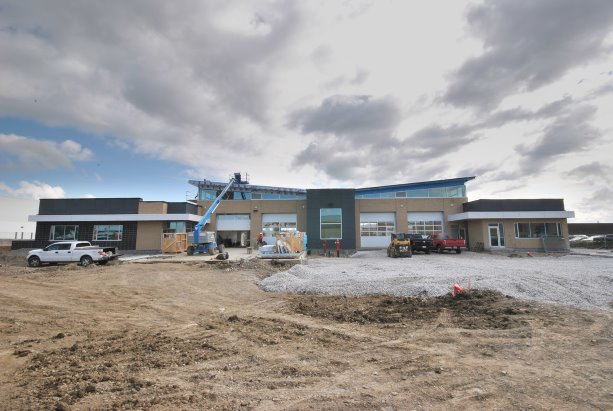Although providing fire and emergency service is the number one priority, a recently opened fire station near Pearson International Airport also showcases environmental design and construction.
Designed by Hossack & Associates Architects and constructed by Everstrong Construction, Mississauga Fire & Emergency Services Station 119 may soon have the distinction of being the first City of Mississauga-owned facility to achieve LEED Gold.
Structural consultant was Stephenson Engineering Ltd. and exp. Inc. was the mechanical and electrical engineer.
"We have enough points, but are still waiting for certification," cautions city project manager Rajiv Chugh.
However, every new municipally owned building in Mississauga larger than 929 square meters (10,000 square feet) has to be designed and built to LEED Silver guidelines and that was the initial target when design commenced in the summer of 2013, he points out.
"In the design process we believed we could achieve LEED Gold," says Chugh, referencing the station’s extensive list of environmental features.
Constructed with masonry brick and cementious board, the facility also houses a tenant Peel Region paramedics satellite station which, although a totally separation operation, was still designed and built to the same standards, he says.
Located on Airport Road adjacent to a hotel in an area known as the Airport Strip, the station is distinguished by a wing shaped roof which acknowledges the role of the airport and the area’s aircraft-related industries.
In keeping with the environmental goal, the roof is also a white-reflective one, he says.
Inside the building there are water efficient sinks, showers, and toilets, low-VOC floor tiles and partial wooden walls with a high recycled material content. An energy ventilator provides fresh air in the interior occupied spaces, with the exception of the vehicle bays and utility rooms.
In the bunker room, which is where the firefighters uniforms and gear are stored, a heat recovery ventilator removes stale and polluted air, while simultaneously bringing in approximately the same amount of fresh air from the outside.
"As the warm air streams pass in the core of the HRV, the outgoing air gives off heat to preheat the incoming cold air which saves energy and money."
Another major feature is a 100 per cent LEED computer-operated light/motion sensor lighting system which will turn lights off on even dull days. Light pours into the station through extra high windows which can be manually operated to reduce reliance on air conditioning, especially during the "shoulder seasons" of spring and fall, he says.
There is also emphasis on natural light in the two-vehicle bay through the use of clerestory lights and three rows of door windows, which Rajiv notes, is somewhat unusual. "In older stations there is only one row."
As part of the requirement to obtain LEED Gold, locally sourced materials, including the masonry bricks, were used, he adds.
Exterior features include a 3,158-square meter (34,000-square foot) concrete paver permeable pavement parking lot and the LED pole lights which overlook it. (The parking lot includes the parking areas, concrete truck aprons and the perimeter driveway around the building but not the asphalt driveway from Airport Road.)
"It’s a proven for us. Mississauga Fire and Emergency Services has already used this product (permeable pavements) successfully at previous fire stations," says assistant fire chief Brian Walsh, citing Fire Station 106 which was built in 2012, the last station built before this one.
The city doesn’t build a new fire station every year, but is in the very design stage of its Fire Station 120 which will be its next station, says Walsh.
Intended to provide fire protection to the area, as well as providing back up support to the Pearson International Airport, the new 119 station replaces a leased facility, he says.
Apart from the environmental aspect, its design and construction also reflects the changing demographics of fire fighters in that it has a female change room, says Walsh.
"We’re now in the process of renovating our existing stations to have them (female change rooms)."











Recent Comments
comments for this post are closed